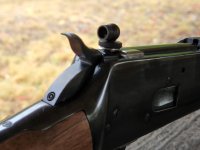... has a 1/4 cock hammer safety, when in that position, it is LOCKED.
You can pull the rod that compresses the rounds in the tube completely out and do a 'mag dump'. Then just cycle the action to be sure nothing is feeding.
The Henry large frame lever guns are unique in having both a side gate and a removable inner magazine tube.
A side gate is essential for ease of reloading in the field while on the move. A tube magazine design without a loading gate doesn’t let you reload while sill being ready to shoot.
On the other hand, there’s no free lunch. The large frame Henry lever guns use a closed top receiver like the Marlin 36 and 336. That makes it much harder to visually confirm the rifle is indeed empty and that the last round did not get hung up.
When I worked in the DC area, I’d attend the large gun show in Chantilly VA. They would have an AD almost every show, an almost without exception ot would be with a a tube fed firearm. A common scenario as an attendee unloading the rifle or shotgun at him or in the parking lot, casing the gun and bringing it inside. Phase two would involve the gun being pulled from the case with the trigger being pulled in the process and the firing pin hitting a round that had hung up in the magazine tube.
In that regard, I am a big fan of tube fed designs that utilize a very open receiver top to make it very easy to visually confirm here are no rounds in the tube by verifying you can see the magazine follower.
I’ll take that over removing the tube and then cycling the action as the Model 94’s open top receiver allows 100% positive assurance the weapon is unloaded.
But again, there are trade offs. With a closed tube magazine it has to be unloaded by cycling all the rounds through the action.
On a newer tang safety Model 94 you can cycle the rounds out of the gun with the safety set on “safe”, and that is the major benefit of having what is still a redundant safety device.
On an old 1894 Winchester with no manual safety, you can still cycle the rounds through the action without closing the lever enough to depress the grip safety, thus also blocking the trigger from any movement.
I do that on mine by placing the end of my pinky finger on the curve of the lever between lever and lower tang so that it creates just enough of a block to allow the extractor to engage the rim, while still preventing the lever from depressing the grip safety. It also leaves enough room inside the lever for the other three fingers so that there is no reason to have your trigger finger dangling outside the lever when unloading, where it might find it’s way to the trigger.
In short, it does not matter what you have. What matters is that you *fully* understand how it operates, what risks it poses, and think through and use effective measures to mitigate those risks when using the firearm.





